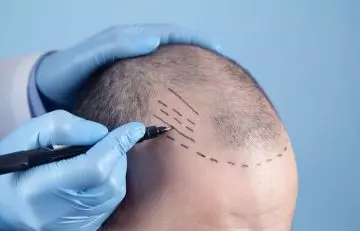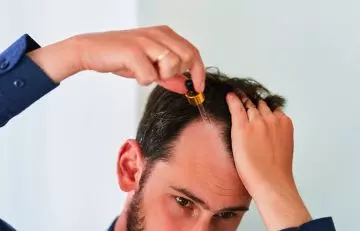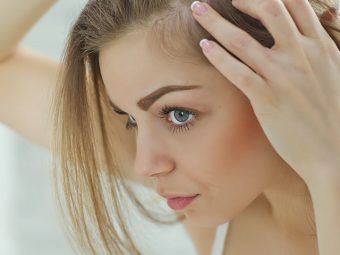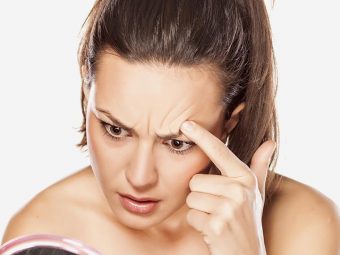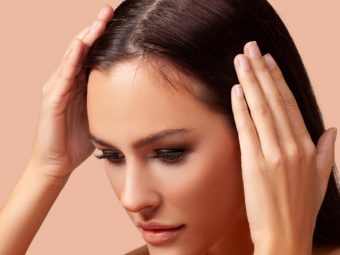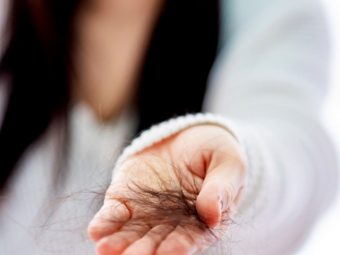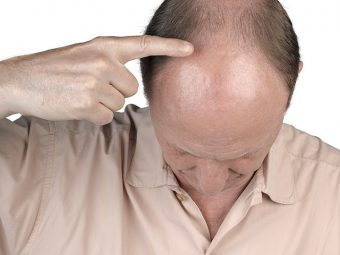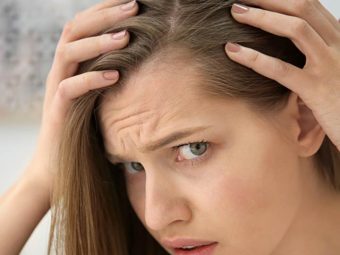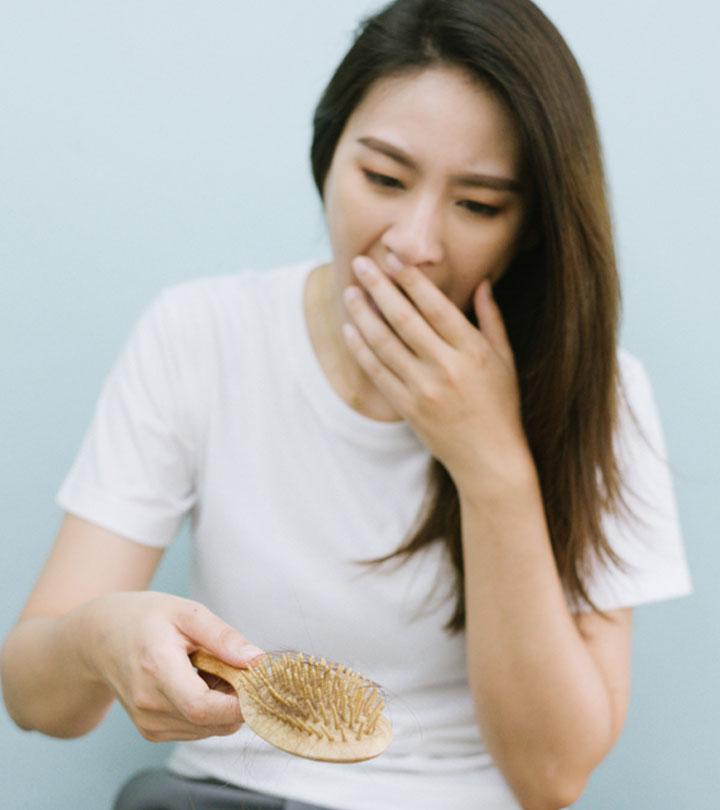Frontal Hair Loss: Causes And How To Treat It
Restore your healthy lifestyle and work on stress reduction to regain your hair.

Image: Shutterstock
The most prevalent type of hair loss in men in their 30s is frontal hair loss or a receding hairline. Frontal balding, popularly called the frontal fibrosing alopecia (FFA) or widow’s peak, is related to the prevalent hair loss condition. This dreadful type of hair loss has a detrimental impact on a person’s look, creating discomfort and lowering their self-confidence. In addition, it is the earliest sign of thinning hair and the first level of male pattern baldness which starts with temple hair loss (1).
In This Article
Symptoms Of Frontal Fibrosing Alopecia, Causes, Treaments
Hair loss from the scalp surrounding the forehead and the brows and armpits is a common symptom of FFA. This condition is thought to be caused by hormonal fluctuations or autoimmune diseases or reactions in the body (2). On the other hand, this unfavorable condition can be addressed and slowed using clinical, therapeutic, and medical procedures and treatments. Maintaining a proper lifestyle and eating a balanced diet is necessary to battle hair loss.
 Quick Tip
Quick TipBut before you begin treating this common issue you need to be able to recognize it. Check out the section below to read about the various symptoms of frontal fibrosing alopecia.
Symptoms Of Frontal Fibrosing Alopecia
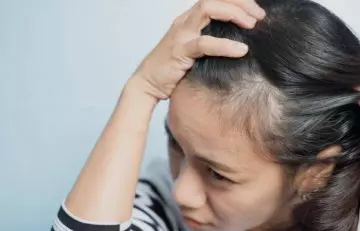
Itchy scalp
This is the most common symptom that individuals develop, where they experience constant itchiness on the scalp or even pain.
Rashes
Rashes on the scalp, face, or hairline can indicate FFA. These rashes may appear as small red or light yellow bumps.
Eyebrow Loss
A significant loss of eyebrows is often associated with frontal fibrosing alopecia. You may notice thinner brows or hair loss on the eyebrow edges.
Receding Hairline
A band of a slightly lighter shade of skin on the forehead may indicate a receding hairline.
Understanding the causes of this hair condition is the first step towards fixing the aforementioned symptoms and the overall issue. Learn more in the next section.
Causes
General hair loss is caused by various factors. Unhealthy diet and lifestyle, physiological and psychological stress resulting in telogen effluvium, improper hair care etiquette or hair styling practices, hormonal changes, scalp infection, illness and medications etc cause hair fall.
However, hormonal changes in the body and scalp and genetic factors are known to be the prime cause for male or female pattern baldness or androgenetic alopecia as well as alopecia areata. The male hormone called dihydrotestosterone or DHT is an androgen that is majorly responsible for frontal balding(1). DHT is responsible for development of manly attributes in males. A very small percentage of DHT is also found in women. Increased level of this hormone in women also causes development of androgynous male secondary sex characteristics, like facial hair, while also prompting sudden hair fall (3).
DHT gets attached to the androgen receptors present in the dermal papillai XA group of mesenchymal cells (cells developing into connective and lymphatic tissues and blood vessels) found under the hair follicle. of the hair follicles and inhibits the proper hair growth. This androgen prevents efficient absorption of growth nutrients from the blood by the papilla causing nutrient deficiencies. This consequently restricts the optimal nourishment of the hair and stops the growth of the hair shaft. Increased level of DHT hormone in the scalp is genetically programmed to cause miniaturizing or shrinkage of the hair follicles. This hampers the creation of new hair follicles thereby leading to reduced hair growth, thinning and loss of hair due to follicle degradation. Thus regulating the levels of DHT in the body and restricting the androgen reception by the hair follicles is essential in solving the problem of frontal balding.
Treatments
Maintaining an appropriate lifestyle, healthy diet and remaining stress free by practicing yoga and meditation can help to naturally tackle the general hair loss issue and FFA problem. Boosting the immune system and keeping illnesses at bay is prerequisite for healthy hair. Use of hot hair treatments, styling tools, chemicals and stressful and tight hairstyling should be avoided as these easily cause the frontal hair to fall easily. Dandruff and other scalp infections along with scalp dehydration leads to blockage of hair follicles by excess sebumi XAn oily substance produced by the skin to keep it moisturized which, in excess, may cause greasy hair and scalp acne. and scalp build up. This leads to insufficient nourishment of the hair which causes weakening of the hair root and eventually loss of hair (4). Hence one should use anti dandruff shampoos and treatments, like nizoral and head & shoulders, to cleanse the scalp and keep it infection free.
Hormonal levels should be regulated and controlled in the body and frontal hair loss treated by use of medicinal drugs, treatments and surgeries like:
Scalp Surgery
Techniques like scalp flab, hair transplant,FUE treatmenti XA hair restoration surgery that involves extracting hair follicles from the back of the head and implanting them on the bald area. , hair growth and restructuring have been used to deal with the frontal hair loss issue.
According to the International Society of Hair Restoration Surgery’s 2022 Practice Census Survey Results, it was estimated 149,254 surgical hair restoration procedures were conducted in the United States and Canada in 2021. Globally, the number of patients undergoing surgical hair restoration procedures reached 628,604. Approximately 87.3% of these procedures were performed on male patients, with the remaining 12.7% being performed on female patients.
It is an expensive treatment and should only be resorted to on recommendation of a doctor in case of chronic FFA.
Minoxidil
This topical lotion or foam needs to be rubbed on the affected region of the scalp every day. This rub on treatment is best to stop and prevent hair loss and to further delay balding. It also promotes regrowth of hair. Favorable results are visible 4 months after the start of the treatment. This is an expensive treatment and hence should be resorted to only on the advice of a doctor or a medical practitioner (5).
Finasteride
This medicine works by inhibiting the conversion of testosterone into dihydrotestosterone of DHT. The decrease in the level of DHT thus positively affects the pores to expand back to their normal size and therefore strengthen the hair and prevent hair loss. Consuming 1 tablet of finasteride each day helps to stop hair loss and promote regrowth of hair. The effect of this medicine is observed 4 months after starting the medication process while it can take up to 2 year for full hair growth to occur (6).
 Trivia
TriviaBatrah, a blogger, shared his emotional challenges with frontal and central baldness. He tried remedies like minoxidil and onion juice but to no avail. After facing much internal anguish, he set on the path to accept his reality, stating, “Slowly n slowly I started accepting the fate ..I started accepting my baldness. ‘My baldness gives me strength’ were the words by Zinedine Zidane, the 1998 fifa world cup hero.I gave up on my baldness and finally regaining my lost confidence after accepting it (i).”
Infographic: Tips To Manage And Deal With Frontal Hair Loss
Losing hair affects your emotional well-being and mental health. While the treatment options may help you deal with the issue, it is best to care for your scalp and hair to prevent any further hair loss. The infographic discusses a few measures you may take, apart from treatment, to protect your hair and scalp and prevent further hair loss. Check it out. Illustration: StyleCraze Design Team
Frontal hair loss, popularly known as widow’s peak, may be caused by stress, poor lifestyle choices, genetics, or hormonal imbalances, and trauma to the scalp, which may also cause traction alopecia, . Studies suggest that dihydrotestosterone is the hormone primarily responsible for frontal balding. You can go for medical treatments such as scalp surgery, medications, or topical ointments to treat hair loss. Furthermore, eating a healthy diet, doing yoga, and avoiding hot styling tools can help combat frontal hair loss and promote the growth of healthy hair. It is advisable to consult your doctor before going for any treatments, especially if the hair loss is due to medical conditions like psoriasis and seborrheic dermatitis.
Frequently Asked Questions
Can you regrow frontal hair?
As long as the hair follicles have not been damaged, you can regrow frontal hair.
Can frontal balding be reversed?
No. Currently, there are no solutions to reverse frontal balding.
Is finasteride better than minoxidil for the frontal hairline?
Both finasteride and minoxidil may help promote hair growth. They give the best results when used together for hairline recession. However, you should not self-medicate as improper use of these medicines may cause irritation and other adverse effects.
Key Takeaways
- Frontal hair loss affects both sexes and may be caused by hormonal imbalance, stress, as a side effect of medications, or lifestyle.
- Controlling stress levels, avoiding heat-styling equipment, and managing dandruff or other scalp infections may help prevent this condition.
- You can approach your trichologist and discuss a regimen of minoxidil and finasteride suitable for your condition to stimulate new hair growth.
Hair loss at 20 can be a scary experience. This video will help you manage hair loss and thinning safely without surgery. Learn how to keep your hair healthy and strong.
Personal Experience: Source
StyleCraze's articles are interwoven with authentic personal narratives that provide depth and resonance to our content. Below are the sources of the personal accounts referenced in this article.
i. The day I started getting bald.https://himanshubatra92.wordpress.com/2015/03/26/the-day-i-started-getting-bald/
References
Articles on StyleCraze are backed by verified information from peer-reviewed and academic research papers, reputed organizations, research institutions, and medical associations to ensure accuracy and relevance. Read our editorial policy to learn more.
- Male pattern androgenetic alopecia
https://www.ncbi.nlm.nih.gov/labs/pmc/articles/PMC1113949/ - Frontal fibrosing alopecia An update on the hypothesis of pathogenesis and treatment
https://www.ncbi.nlm.nih.gov/labs/pmc/articles/PMC6451751/ - Androgen actions on the human hair follicle: perspectives
https://onlinelibrary.wiley.com/doi/full/10.1111/exd.12024 - Scalp Condition Impacts Hair Growth and Retention via Oxidative Stress
https://www.ncbi.nlm.nih.gov/labs/pmc/articles/PMC6369642/ - Minoxidil and its use in hair disorders a review
https://www.ncbi.nlm.nih.gov/labs/pmc/articles/PMC6691938/ - Finasteride-mediated hair regrowth and reversal of atrophy in a patient with frontal fibrosing alopecia
https://www.ncbi.nlm.nih.gov/labs/pmc/articles/PMC4809380/







